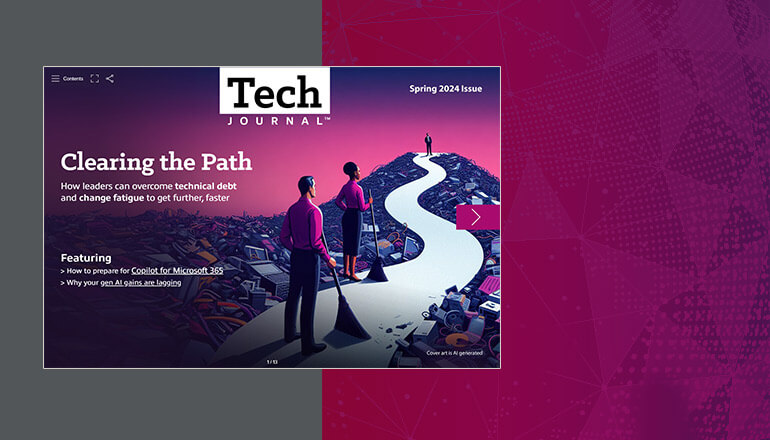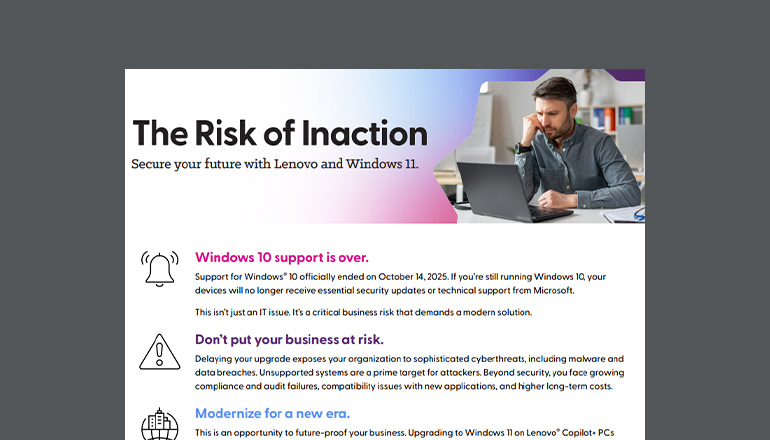Blog
7 Things Your Dev Team Secretly
Wants You to Know
Looking to build stronger alignment between leadership and dev teams? A few of our developers share tips for success.
By Insight Editor / 23 Sep 2020 / Topics: Agile Application development Modern workplace Digital transformation

As the digitization of products and services becomes increasingly integral for modern business, so does the role of the developers within your organization.
But particularly for those with traditionally limited experience in the realm of software development, finding the best way to integrate, coordinate and communicate with these teams can be tricky. Between navigating new vocabulary and managing incremental delivery cycles, it can feel as though leadership and development teams are speaking two different languages.
At times, this can lead to a sense of disconnect between leaders and the developers bringing their vision to life. But both ultimately want the same thing: to create a quality product that successfully resolves a customer challenge and has a meaningful impact on their own business goals.
So, how can you begin to achieve greater alignment and empower your dev team to deliver stronger outcomes faster? It starts with a better understanding of the way they work and the role they play within your organization.
Insight’s own Agile advisory services team offers an inside look at what leadership and others need to know about the world of software development.
1. What is the role of a developer?
Ultimately, a developer’s job is to deliver working product. But there’s a lot more involved than just writing code. Gone are the days when we could simply sit in a dark room typing at a computer while managers slid pizza and Mountain Dew under the door to keep us going.
In order to build the most effective software solutions possible, today's developers need to start with a holistic understanding of the problem domain. This means working closely with product owners to explore business needs, research pain points and evaluate system constraints. Developers should be actively involved and encouraged to be curious about customer challenges throughout the product development process. The more accurate the initial understanding of the goal, the more quickly and efficiently we can begin to build a solution.
Developers should also be up to date on technologies to accomplish solutions, and able to work with other team members to maximize their chances of success.
2. What’s the biggest misconception about what a development team does?
Many assume that developers simply execute against a list of exhaustive requirements without knowing or caring about the business drivers or needs of the end user. The fact is this information is crucial to ensuring software solutions are not only functional but applicable to the desired use case. As developers, we need strategic and ongoing feedback from the customer to ensure the product meets expectations as intended. We can design incredibly advanced applications, but at the end of the day, if they don’t solve a real-world problem, the project will ultimately be considered a failure.
When it comes to execution, one of the biggest mistakes leadership teams make is in thinking of development as a formulaic process. Many managers have a tendency to get stuck in the mindset that a developer is only useful if their hands are on the keyboard. While it’s true that this is where the rubber meets the road, the true magic happens in the “whitespace” when developers are staring out the window brainstorming solutions, working with others to kick ideas around or researching how similar problems have been tackled.
In short, software engineering isn’t like a factory where throughput can be easily dialed up and down. It’s a creative pursuit that requires ingenuity and a supportive culture. Recognizing and finding ways to empower this creative process is key to helping your dev team deliver effective, innovative products.
3. What needs to be done before starting a dev project?
When there’s a new idea or opportunity for growth, it can be tempting to dive right into development — but before scheduling a kickoff meeting, there are a few things to establish first.
First and foremost, you’ll need an empowered product owner. For those unfamiliar with the role, this individual is responsible for managing the product backlog to ensure the final product meets its intended goals. An empowered product owner is one who possesses not only the knowledge but also the authority to push back, ask questions and say no to certain requests.
Both the product owner and dev team need to be involved early in understanding the drivers behind the project. Developers are natural problem solvers — we love devising innovative solutions to address the challenges our customers face. The sooner we understand these challenges, the sooner we can begin brainstorming creative ways to resolve them.
Involving development teams early and using constant releases to validate assumptions will yield exponential benefits compared to the traditional way of working. But this means your organization will need to make a conscious, collective shift toward adopting an iterative mindset that welcomes feedback and readily adapts to changing requirements.
Unlike more traditional means of project management, plotting out a timeline and dividing by the number of developers on your team simply won’t cut it. People aren’t resources and the development process isn’t a math equation — this approach will only stifle innovation and creativity on your dev team.
Instead, commit to embracing new ways of thinking and working to promote the value of experimentation and continuous learning.
4. What are the consequences of poor communication?
Good communication with your dev team establishes clear expectations, eliminates unused features and helps prevent frustration among team members who may otherwise be unable to see the value in what they do. Poor communication or miscommunication, on the other hand, quickly and inevitably leads to waste.
This typically occurs in some form of the telephone game. Information gets passed from one messenger to the next so that by the time it reaches the dev team, details are lacking, needs are misinterpreted and we end up building solutions for a problem that isn’t important, or worse, doesn't actually exist.
Preventing these issues starts with eliminating the “middle men” whenever possible to create a more direct connection between the problem solvers and the actual problem. Your organization will need to establish strong alignment and a clear, consistent communication strategy to prevent rework, reduce burnout and ultimately create greater value for customers.
5. What are some common challenges you’ve faced on development projects?
While specific issues may vary from project to project, there are a few common factors that can quickly turn any task into a challenge.
A lack of strong relationships and human connections between the dev team, product owner and stakeholders can make it difficult to collaborate effectively. Lack of consistent direction around product needs or expectations — including unrealistic or arbitrary timelines — can lead to misspent energy, stress and ultimately a lack of trust between teams.
Fortunately, all of these issues can be prevented or resolved with trust, which leads to radical candor and improved focus on the desired impact of a project, rather than on simply meeting deadlines.
6. What do you wish leaderships teams knew about Agile?
Many organizations assume that implementing Agile practices makes you Agile — it doesn’t. Being dedicated to delivering value and responding to change is what makes an organization truly Agile, and it requires a commitment beyond your development team.
Embracing an Agile mindset starts with a systemic shift, first and foremost, from leadership. Leaders often make the mistake of thinking Agile doesn’t apply to them, that it’s a quick framework to be implemented within the scope of development without any additional changes to traditional reporting or management style.
In fact, leaders play a key role in successful Agile transformation by helping to align organizational values, establishing effective teams, creating clarity around expectations and removing cultural or procedural obstacles to iterative delivery. The more actively involved in championing the change, the more readily the business will be able to embrace more nimble, agile ways of working.
Leaders should also note there is no secret recipe. Agile is a culture that must be constantly assessed and cultivated to ensure both initial and ongoing value.
7. What are the most important qualities in a leader when it comes to accelerating and improving product delivery?
For developers, the most important aspects of leadership come down to the three Cs:
Coherency – Leaders must provide a clear sense of purpose and possess the ability to clearly express not only what the goals and requirements for a product are, but how they align to the business. They should be knowledgeable on the problems we are trying to solve and why. They also need to be able to make strategic decisions quickly to support ongoing delivery of product value.
Consistency – Leaders need to ensure priorities are organized and maintained so that teams ultimately deliver a product that meets the intended need. By continuously communicating the “why,” they help their teams stay connected to the problems they’re trying to solve while empowering them to change course as needed to achieve these goals.
Collaboration – A good leader brings ideas to the table but understands and respects the expertise of those executing. They should be an active listener, willing to accept feedback and admit when their idea isn’t the best. They should be eager to empower the autonomy needed to creatively solve problems, and ready to other leaders rather than acting as a funnel or bottleneck in the process.
By working toward a better understanding of the development process and the multifaceted roles developers play within your organization, leaders can begin to create better alignment, communication and empowerment of development teams.
This, in turn, will build the trust and autonomy needed to deliver higher-quality products faster while maximizing the positive impact on your own business goals.









